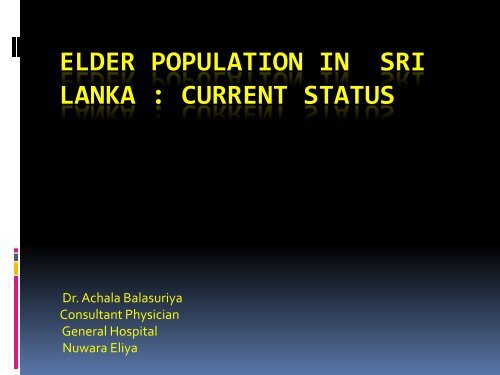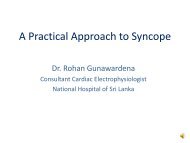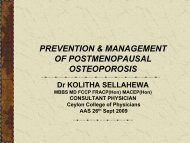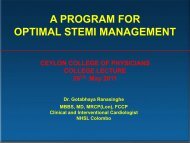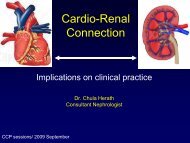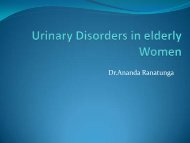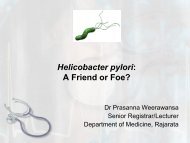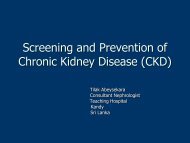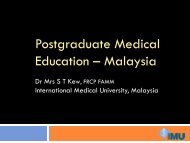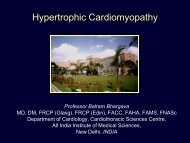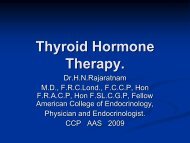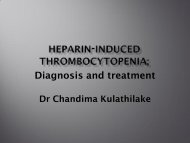elder population in sri lanka
elder population in sri lanka
elder population in sri lanka
You also want an ePaper? Increase the reach of your titles
YUMPU automatically turns print PDFs into web optimized ePapers that Google loves.
ELDER POPULATION IN SRI<br />
LANKA : CURRENT STATUS<br />
Dr. Achala Balasuriya<br />
Consultant Physician<br />
General Hospital<br />
Nuwara Eliya
Topics<br />
• Introduction<br />
• Demography<br />
• Factors affect<strong>in</strong>g the demographic trend<br />
• National survey f<strong>in</strong>d<strong>in</strong>gs<br />
• Services available for <strong>elder</strong>s <strong>in</strong> SL<br />
• Problems face by the <strong>elder</strong>s<br />
• Proposals for the future
Introduction<br />
• Population age<strong>in</strong>g is a universal phenomenon , but it<br />
looms particularly large for Sri Lanka .It’s <strong>population</strong><br />
is the oldest among the develop<strong>in</strong>g world and it is<br />
one of the fastest age<strong>in</strong>g <strong>population</strong>s <strong>in</strong> the world.<br />
Def<strong>in</strong>ition of age<strong>in</strong>g<br />
• Refers to <strong>in</strong>crease <strong>in</strong> the relative proportion of <strong>elder</strong>ly <strong>in</strong><br />
<strong>population</strong>.<br />
• Western world age over 65 and above is regarded as the<br />
demarcation age.<br />
• Develop<strong>in</strong>g world age 6o and above is considered to be<br />
the cutoff po<strong>in</strong>t.
Demography<br />
Population <strong>in</strong> Sri Lanka at present 20,450,000.<br />
Elders over 60 - 11%<br />
Projected figure for 2030- 22%<br />
In 2030, one <strong>in</strong> 5 people will be over the age of<br />
60 years.<br />
Among <strong>elder</strong>s female numbers are higher than<br />
males due to <strong>in</strong>crease <strong>in</strong> life expectancy.
Age<strong>in</strong>g <strong>in</strong> Sri Lanka – South and Central<br />
Asian perspective<br />
Country Percentage of 60+<br />
2000<br />
Afghanistan<br />
4.7<br />
Percentage of 60+<br />
2030<br />
5.5<br />
Bangladesh<br />
Bhutan<br />
India<br />
Nepal<br />
Pakistan<br />
Sri Lanka<br />
4.9<br />
6.5<br />
7.6<br />
5.9<br />
5.8<br />
9.8<br />
9.7<br />
7.6<br />
14.0<br />
7.8<br />
7.8<br />
21.5
Number and percentage of <strong>elder</strong>s 60+ years<br />
1946-2031, Sri Lanka<br />
Year Total <strong>population</strong> Percentage age 60+ years<br />
(‘000) (%)<br />
1946 6,657 5.4<br />
1953 8,098 5.4<br />
1971 12,690 6.3<br />
1991 17,259 8.1<br />
2002 19,015 10.8<br />
2011 20,873 13.1<br />
2021 22,324 17.8<br />
2031 23,129 21.9
Young and old age dependency ratio<br />
Year Under 15 65 and older Total<br />
1991<br />
49.2<br />
8.5<br />
57.7<br />
1996<br />
42.4<br />
9.3<br />
51.7<br />
2001<br />
37.0<br />
10.1<br />
47.1<br />
2006<br />
34.7<br />
11.1<br />
45.8<br />
2011<br />
33.1<br />
12.7<br />
45.8<br />
2016<br />
31.4<br />
15.1<br />
46.4<br />
2021<br />
29.3<br />
18.1<br />
47.4<br />
2026<br />
27.5<br />
21.4<br />
49.0<br />
2031<br />
26.1<br />
24.4<br />
50.5
District variation <strong>in</strong> <strong>elder</strong>ly <strong>population</strong>
Demographic trends and factors<br />
affect<strong>in</strong>g Population Age<strong>in</strong>g<br />
• 1. Decl<strong>in</strong>e <strong>in</strong> fertility<br />
The ma<strong>in</strong> driver of the slow<strong>in</strong>g momentum of <strong>population</strong> growth has<br />
rapid fertility decl<strong>in</strong>e s<strong>in</strong>ce the 1950s.<br />
been<br />
Total fertility rate<br />
Crude birth rate<br />
• 1953 - 5.3 1946 - 36.6<br />
• 1993 -2.3 1970 - 29.4<br />
• 2001 -2.1 2009 - 18.4<br />
Increas<strong>in</strong>g life expectancy is the next most important driver of SriLanka’s<br />
<strong>population</strong> age<strong>in</strong>g: lower mortality prolongs the survival of older persons. The<br />
proportion of oldest – old is 12% which is<br />
highest <strong>in</strong> south-Asia.
Demographic trend cont<strong>in</strong>ued…..<br />
2.Increased life expectancy – low mortality<br />
Crude death rate<br />
1945 - 21.9<br />
1971 - 7.7<br />
1995 - 5.8<br />
Life expectancy<br />
1920 1946 1953 1962 1967 1971 1981 1991 2001<br />
M<br />
F<br />
32.7<br />
30.7<br />
43.9<br />
41.6<br />
58.8<br />
57.5<br />
61.9<br />
61.4<br />
64.8<br />
66.9<br />
64.2<br />
67.1<br />
67.7<br />
72.1<br />
69.5<br />
74.2<br />
70.7<br />
75.4<br />
3.Improved health care<br />
4.Population migration
National Survey on Elders: 2003-2004<br />
• Carried out to obta<strong>in</strong> reliable <strong>in</strong>formation on <strong>elder</strong>ly <strong>population</strong><br />
of Sri Lanka.<br />
• Covered rural ,urban and estate sectors <strong>in</strong> all districts.<br />
• Survey covered 11,663 and based on this total estimated<br />
<strong>elder</strong>s <strong>in</strong> the country was 1,661,000.<br />
• Objectives<br />
• Ascerta<strong>in</strong><strong>in</strong>g the specific distribution of the <strong>elder</strong>ly <strong>population</strong><br />
• Obta<strong>in</strong><strong>in</strong>g details of the demographic, economic, health and<br />
social characteristics of the <strong>elder</strong>ly <strong>population</strong>.<br />
• Identify<strong>in</strong>g the social needs of the <strong>elder</strong>ly, difficulties faced <strong>in</strong><br />
domestic and social environment.<br />
• Generat<strong>in</strong>g other ancillary <strong>in</strong>formation helpful to make policies<br />
and services for the well be<strong>in</strong>g of the <strong>elder</strong>ly.
Summary f<strong>in</strong>d<strong>in</strong>gs of this survey<br />
Distribution of <strong>elder</strong>s by sector<br />
• 83.9- rural<br />
• 12.3-urban<br />
• 3.8-estate
Distribution of Elders by gender accord<strong>in</strong>g to<br />
sector
Distribution of <strong>elder</strong>s accord<strong>in</strong>g to age
Distribution of <strong>elder</strong>s accord<strong>in</strong>g to See<strong>in</strong>g ability
Distribution of <strong>elder</strong>s accord<strong>in</strong>g to hear<strong>in</strong>g ability
Elders accord<strong>in</strong>g to illness
Other<br />
4.1<br />
3.4<br />
3.8<br />
Distribution of <strong>elder</strong>s by ma<strong>in</strong> source of<br />
<strong>in</strong>come and by sector ( percentage)<br />
Source All(%) Urban (%) Rural (%) Estate (%)<br />
Salary<br />
8.6<br />
6.9<br />
16.9<br />
Pension<br />
25.1<br />
11.8<br />
2.6<br />
Property<br />
2.2<br />
8.8<br />
0.8<br />
Bank Interest<br />
1.3<br />
0.4<br />
0.4<br />
Bus<strong>in</strong>ess/Agri<br />
4.4<br />
11.5<br />
3.9<br />
Children<br />
44.6<br />
45.9<br />
61.8<br />
Samurdhi<br />
2.6<br />
5.9<br />
3.3<br />
Relatives<br />
6.2<br />
4.8<br />
6.2
Socio- economic characteristics of the <strong>elder</strong>ly<br />
• Among <strong>elder</strong>ly there is a large share of women and<br />
widows.<br />
• The female share <strong>in</strong>creases with advanc<strong>in</strong>g age.<br />
60-64 years 70- 74 years 80 and above<br />
53% 60% 70%<br />
• Poverty does not affect <strong>elder</strong>ly disproportionately more<br />
than the <strong>population</strong> as a whole. But <strong>in</strong>cidence of poverty<br />
among the old old (75+)is very high.<br />
• Nearly 60% were economically dependent- 46% on their<br />
children<br />
• Majority of <strong>elder</strong>s (71%) reside <strong>in</strong> houses owned by them<br />
or rented by them and co residence rates are very high-<br />
80%.Only 6% of <strong>elder</strong>s live alone.
Services available for <strong>elder</strong>s<br />
through GOSL<br />
• 1.National Council for Elders - established under<br />
Protection of Rights of Elders Act No 9 of 2000.<br />
• Council comprises 15 members chaired by the<br />
secretary of M<strong>in</strong>istry of Social Services and Welfare.<br />
Objectives<br />
• Protect<strong>in</strong>g and promot<strong>in</strong>g rights of <strong>elder</strong>s<br />
• Identify<strong>in</strong>g problems faced by <strong>elder</strong>s and mak<strong>in</strong>g and implement<strong>in</strong>g<br />
policies accord<strong>in</strong>gly<br />
• Implement<strong>in</strong>g various types of programmes by us<strong>in</strong>g their knowledge<br />
and experience<br />
• Conduct<strong>in</strong>g awareness programmes for <strong>elder</strong>s<br />
• Provid<strong>in</strong>g guidance and various types of welfare assistance for low<br />
level <strong>in</strong>come group of <strong>elder</strong>s<br />
• Updat<strong>in</strong>g data related to <strong>elder</strong>s
Services cont<strong>in</strong>ued ………<br />
• 2. National Secretariat for <strong>elder</strong>s - Established under the<br />
Elderly Act 9 of 2000<br />
Ma<strong>in</strong>tenance board for <strong>elder</strong>s- to look <strong>in</strong>to claims for<br />
ma<strong>in</strong>tenance by parents who are neglected by their children<br />
• Elderly Identity cards- which enables the >6o group to obta<strong>in</strong><br />
priority services from Gov and private sector <strong>in</strong>stitutions ;<br />
higher <strong>in</strong>terest rates for FDs; 5 % discount when obta<strong>in</strong><strong>in</strong>g<br />
medic<strong>in</strong>es from Osusala outlets.<br />
• So far 625,000 identity cards have been issued.<br />
• Issue of eye lenses- for low <strong>in</strong>come (Rs < 5000/=) group<br />
• Day care centers- Provides f<strong>in</strong>ancial assistance up to Rs<br />
25,000 for each day care centre for purchase of equipment<br />
and also provides of Rs 10,000 for needy <strong>elder</strong>s to start self<br />
employment activities
Distribution of day centers for the <strong>elder</strong>ly<br />
Distribution of day centers for <strong>elder</strong>ly, by prov<strong>in</strong>ce<br />
• Western 31<br />
• Southern 21<br />
• Central 27<br />
• North-Western 12<br />
• North-Central 32<br />
• North-Eastern 5<br />
• Sabaragamuwa 15<br />
• Uva 4<br />
Total 147
Cont<strong>in</strong>ued..<br />
• Establishment of village committees- both at village level<br />
and district level- for social , economic cultural an d<br />
spiritual development of <strong>elder</strong>s ( National Secretariat<br />
provides f<strong>in</strong>ancial assistance of Rs 5000 for a village)<br />
• Provision of funds to establish and ma<strong>in</strong>ta<strong>in</strong> <strong>elder</strong>ly<br />
homes<br />
• Provision of a old age pension to <strong>elder</strong>s over 70 years<br />
• Do<strong>in</strong>g surveys among <strong>elder</strong>s<br />
• Arrang<strong>in</strong>g home care services<br />
• Conduct<strong>in</strong>g pre retirement sem<strong>in</strong>ars for both State and<br />
private sector employees<br />
• Sponsorship programme for <strong>elder</strong>s established<br />
• Elders desk has been opened at the legal aids commission to<br />
help the needy <strong>elder</strong>s.
Services by NGOs<br />
• Helpage Sri Lanka-<br />
Established <strong>in</strong> 1986 guided by<br />
the 1 st World Assembly on Age<strong>in</strong>g<br />
Initiatives<br />
• Volunteer home care programme<br />
• Conduct<strong>in</strong>g mobile medical camps<br />
• Provision of assistive devices for the <strong>elder</strong>ly<br />
• Tra<strong>in</strong><strong>in</strong>g home carers<br />
• Livelihood assistance<br />
• Paid care facility<br />
• Psychosocial <strong>in</strong>tervention programmes<br />
• Eye care centre
Problems faced by the <strong>elder</strong>ly <strong>in</strong> SL<br />
In hospital care<br />
• Elderly patients receive no priority <strong>in</strong> hospitals and<br />
are managed <strong>in</strong> a common ward.<br />
(No designated geriatric wards <strong>in</strong> both Gov and<br />
private sector hospitals)<br />
• No specialist geriatricians<br />
• Junior doctors lack knowledge and skills to manage<br />
geriatric compla<strong>in</strong>ts- eg: delirium, dementia<br />
,depression are often overlooked<br />
• Lack of properly tra<strong>in</strong>ed allied healthcare supportphysiotherapists,<br />
occupational therapists , speech<br />
therapists and social workers .
Cont<strong>in</strong>ued<br />
• Lack of geriatric rehabilitation facilities <strong>in</strong> the State<br />
hospitals; equipment, tra<strong>in</strong>ed manpower, space and<br />
other facilities<br />
• Community Services<br />
• No community geriatric services<br />
• Lack of tra<strong>in</strong>ed nurses and healthcare workers who<br />
can start up such a service<br />
• Inadequate number of nurs<strong>in</strong>g homes and <strong>elder</strong>ly<br />
homes to look after the very old, frail, and sick<br />
• Lack of respite services to help of care -givers
Proposals for future<br />
Re orient<strong>in</strong>g the health system to respond to an<br />
age<strong>in</strong>g <strong>population</strong><br />
Integrate primary prevention and primary healthcare<br />
for <strong>elder</strong>ly us<strong>in</strong>g PHC network of the MOH for<br />
geriatric assessment , prevention and rehabilitation.<br />
Cadre creation of Geriatricians and Para medical<br />
personnel to prov<strong>in</strong>cial hospitals<br />
To develop and design the hospital healthcare<br />
system with geriatrics as a sub-specialty so that<br />
properly planned wards, gymnasium , and<br />
rehabilitation devices can be <strong>in</strong>stalled.<br />
Introduce geriatrics <strong>in</strong> to the medical curriculum<br />
at the undergraduate and postgraduate streams.
Cont<strong>in</strong>ued….<br />
In the short term-<br />
‣ Improve health service delivery at primary,<br />
secondary, tertiary levels with preference for <strong>elder</strong>s<br />
at OPD, Pharmacy and a referral system from<br />
community physicians.<br />
‣ Nurs<strong>in</strong>g officers’ tra<strong>in</strong>ed to help <strong>in</strong> the community to<br />
visit patients’ , homes, <strong>elder</strong>ly homes and to run<br />
community geriatric cl<strong>in</strong>ics .<br />
‣ For m<strong>in</strong>or ailments a geriatric day hospital service at<br />
MOH areas , us<strong>in</strong>g the same premises, with<br />
supervision of diploma holders(DEM).
Proposals for future ……….<br />
Support<strong>in</strong>g <strong>in</strong>formal care arrangements<br />
• Introduce / expand social welfare and care services<br />
targeted to the most vulnerable.<br />
• Provide community and home based support<br />
services for sick and frail old people.<br />
• Improve <strong>in</strong>come support programmes for <strong>elder</strong>ly so<br />
that they can contribute to household welfare.<br />
• Increase capacity of nurs<strong>in</strong>g homes to care for the<br />
<strong>elder</strong>ly .
Ensur<strong>in</strong>g <strong>in</strong>come security<br />
• Provide opportunities and start facilities to assist<br />
<strong>elder</strong>s to use their knowledge ,experience and skills<br />
to earn an <strong>in</strong>come.<br />
• Extend the statutory age of retirement from 55 years<br />
to 65 years <strong>in</strong> view of <strong>in</strong>creas<strong>in</strong>g life expectancy and<br />
good health.<br />
• Convert unfunded pension schemes to funded ones<br />
to facilitate susta<strong>in</strong>able pension payments for the<br />
retirees.<br />
• Ensure adequate <strong>in</strong>come security and social<br />
protection of needy senior citizens by expand<strong>in</strong>g<br />
social assistance .
Thank you for your<br />
undivided attention.


